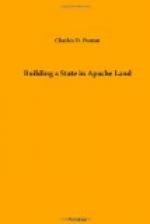In December, 1856, I purchased for the company the estate of “La Aribac,” or Arivaca, as it is called by Americans. This place is a beautiful valley encompassed by mountains, and containing only a few leagues of land. It was settled by Augustine Ortiz, a Spaniard, in 1802, and title obtained from the Spanish government. The ownership and occupation descended to his two sons, Tomas and Ignacio Ortiz, who obtained additional title from the Mexican Republic in 1833, and maintained continuous occupation until 1856, when they sold to the company for a valuable consideration.
The validity of the title has been denied by the United States, notwithstanding the obligations of the treaty, and is now pending before the United States Land Court, with the prospect of an appeal to the United States Supreme Court, with a fair prospect of the ultimate loss of the property. The company conveyed the property with all mines and claims in Arizona to the writer, on the 2nd January, 1870,—a woful heritage.
In the early months of 1857, everything was going well in the Santa Cruz valley. The mines were yielding silver bullion by the most primitive methods of reduction. The farmers were planting with every prospect of a good crop. Emigrants were coming into the country and taking up farms. Merchants were busy in search of the Almighty Dollar or its representative.
The only disturbing element in the vicinity was a little guerilla war, going on in Sonora between two factions for the control of the State government. Gaudara was the actual governor, and had been so for many years, during which time he had accumulated a handsome fortune in lands, mills, mines, merchandise, live stock, and fincas. He was a sedate and dignified man, much respected by the natives, and especially polite and hospitable to foreigners. Pesquiera was an educated savage, without property or position, and naturally coveted his neighbor’s goods. Consequently a revolution was commenced to obtain control of the governorship of the State; and just the same as when King David sought refuge in the cave of Adullam, all who were in debt, all who were refugees, all who were thieves, and all who were distressed, joined Pesquiera to rob Guadara. This is all there was,—or ever is, to Mexican revolutions.
On the discovery of gold in California, many Mexicans went from Sonora to California and remained there. Among these was one Ainsa, of Manila descent, married to a native of Sonora, who migrated to California with a large family of girls and boys in 1850, and had a Bank and Mexican Agency on the northwest corner of Clay and Montgomery streets, where there was the usual sign,—
Se COMPRA Oro
Up Stairs
The girls of the Ainsa family grew to womanhood, and carried the beauty and graces of Sonora to a good market. They all married Americans, and married well.




